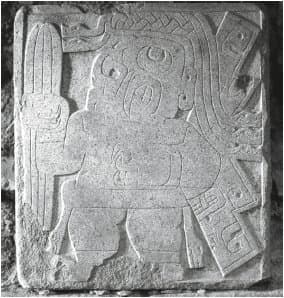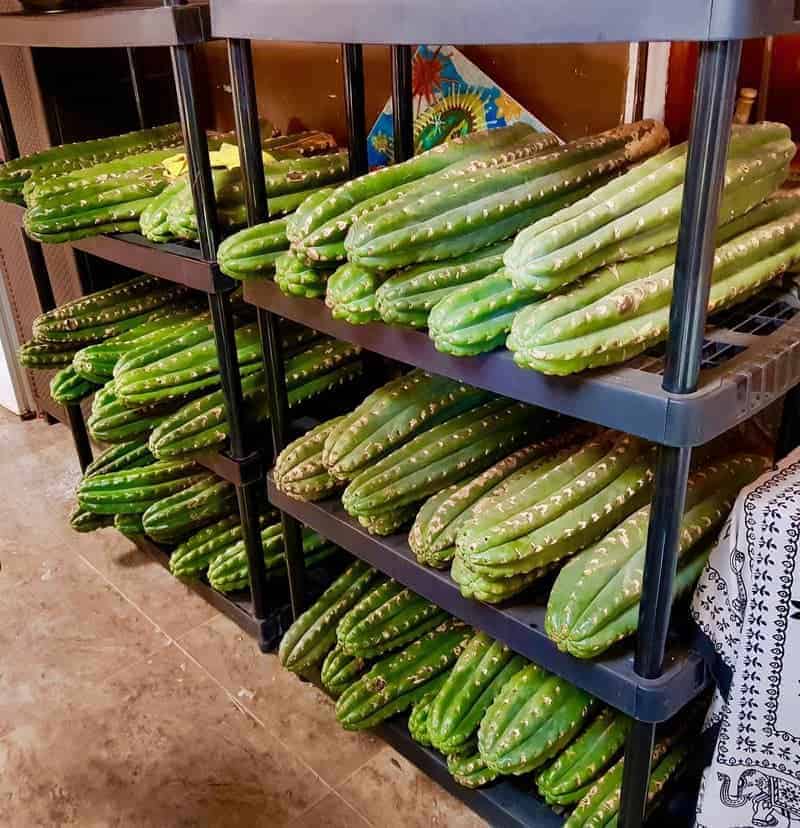Reading time: 24 Minutes
In this article you will really discover everything about San Pedro:
Introduction: History
Echinopsis Pachanoi, also known as San Pedro Cactus, is a cactus native to the Andes of Peru, Bolivia, and Ecuador. It grows at an altitude of about 1000-3000 meters and is widely used as an ornamental plant. In these countries, however, it is best known for its hallucinogenic and healing properties. Especially the Moche civilization has made use of it using the cactus for healing and divination purposes.
In South America, the Echinopsis Pachanoi is known by many different names: Wachuma, Huachuma, Agua colla, Gigantón, Sanpedrillo, Olala, Huando hermoso, Huando, Huacuma, Curi, Cardo, Cactus Real, Agua-collo, Huachuma, Gigantón, Símora, San Pedrillo, Huando hermoso, Huachumo, Cuchuma, Cimora blanca, Cimarrón, Cardon, Andachuma, Cardón santos, San Pedro, Cactus de San Pedro, Achuma, Hahuacollay Giganton,Aguacolla etc...
It is said that the traditions of using the San Pedro cactus in Peru date back more than 3000 years. The oldest archaeological evidence suggesting the use of San Pedro is a stone carving (see photo below) of a huachumero shaman of the Chavín civilization in the old temple of Universal Consciousness at Chavín de Huantar, in northern Peru.
According to archaeologists, the carving dates back to at least 1500 BC, and probably even beyond. There are also old Chavin textures that portray the cactus with jaguars and hummingbirds surrounding it.

Photo distributed under license CC BY-SA 4.0
Why call a cactus “San Pedro”?
It is difficult to establish a continuity of use between the traditional use and the current one of San Pedro in the Andes area. One thing that is certain, however, is the fact that the use of the plant changed dramatically with the arrival of the Spanish conquerors. Coming from the traditional view of the Christian world, the use of San Pedro has been transformed to serve the doctrine of the church.
In fact, the name "San Pedro" refers to the St. Peter of the New Testament.
According to legend, it was St. Peter who held the keys to the heavenly doors; a strong reference to the transcendent moods that San Pedro can induce.
Still today, the cactus is used by the indigenous people of the Andes and on the coasts of Peru and Ecuador for the same medicinal and therapeutic purposes that are inherent in the plant.
Today's San Pedro ceremonies take place for the same reasons as ever: to cure spiritual, emotional, mental or physical diseases, to predict the future through the prophetic and divinatory qualities of the plant, to fight witchcraft, to bring success to their exploits and to awaken love and enthusiasm for life. It may be precisely for these reasons that South America has seen a strong increase in tourism for San Pedro in recent years.
San Pedro as Medicine: Properties and Usage
The San Pedro Ceremony is truly transformative and surprising. The San Pedro is a very powerful cure, the effect lasts twice as long as the Ayahuasca, and opens the heart to love and peace towards oneself and the world. Ayahuasca is often represented as the female part of the two sacred master plants and San Pedro is the male part. My shaman friends in Peru say that Ayahuasca shows you what you need to change, gives you an idea of your challenges and problems, and San Pedro (Wachuma) gives you the power to make that change happen.
Often, in a healing experience, the mind is on the way to the wisdom of the heart. The San Pedro goes straight to the heart and bypasses the defenses of the mind and the resistance of the ego. There can therefore be surprising transformations for people who have a lot of mental activity that holds them back from healing, with fantastic openings of the heart's energy center.
Ayahuasca is more of an inner journey into the universe within you, while San Pedro is more of an outer journey that shows you how other dimensions merge with physical reality, showing you your multidimensional nature. Your motor skills are not as affected by the San Pedro as they are by the Ayahuasca, which is why you usually take walks in nature during the ceremony.
Among the most common effects that this master plant can make you feel there is the possibility to bring back to mind distant memories, which you thought you had forgotten on which you can then go to work with the help of the spirit of San Pedro. You can also acquire an increased ability to see and feel the world around you by feeling an unconditional love for any being or earthly creature and for any inanimate form and entity.
Throughout the history of its use, San Pedro has been known to function as a powerful medicine with the ability to cure "unknown diseases". While one can belittle this conception as a simple superstition of primitive tribes in the Andes, there is actually science that suggests medicinal benefits from taking San Pedro. Research has shown that San Pedro is able to reduce hypertension, reduce the risk of heart disease, treat nerve disease and alleviate joint problems.
Cactus San Pedro has also been associated with powerful antimicrobial properties that prevent the growth of more than a dozen strains of penicillin-resistant bacteria, such as Staphylococcus.
San Pedro contains high concentrations of the psychoactive compound called mescaline, so there is much controversy surrounding this "substance". It should be kept in mind, however, that mescaline does not produce physical dependence.
How is the San Pedro Cactus? Description.
The Cactus of San Pedro, is a columnar plant, is very branched and its stem is green. It can grow up to 6 meters or more.
The flowers are born near the top of the stems, open at night, are white, about 20 cm and very fragrant. They are short lived, as they usually last one or two days. Then they wither and fall off.
The fruits are edible, dark green and about 5 to 6 cm long.
Due to the presence of alkaloids (mescaline), both the fruits and the cactus itself have hallucinogenic properties when ingested.
It is a shrub-like cactus with erect branches from the base. The stems are cylindrical, dark green, 5 m long and 8-15 cm in diameter.
It usually has up to 7 thorns, brown, between 0.5 and 2 cm long.
The fruit is edible and has a mild flavor.
Is the San Pedro cactus hallucinogenic?
San Pedro Cactus: Natural Mescaline
The San Pedro cactus is undoubtedly one of the oldest magic plants in South America: it has been used for more than 3,300 years. Known by its botanical name of Trichocereus pachanoi, it is a fast-growing, blue-green columnar cactus that can reach six meters in height and grow at a rate of up to forty centimeters per year. Its maximum height is twelve meters.
The arms of the cactus, which can have from 4 to 8 ribs, reach ten centimeters in diameter when the cactus is older than seven years; the specimens with four ribs are especially appreciated by shamans, these four ribs symbolizing the four cardinal points. In general, the specimens mature at the age of 7 and lose their thorns, as if they wanted to indicate that they are ready to form part of a magic potion, while in the young specimens these appear in number from 3 to 7, reaching 2 cm in length. When the cactus reaches a certain height, it begins to branch out, becoming a kind of candelabra. This allows several cuttings to be cut from a single cactus. It grows and is cultivated in Ecuador, Peru, Bolivia and northern Argentina, both in coastal regions and in the Andes. When the Spanish invaded Peru, the ritual use of the San Pedro cactus for healing and spiritual magic was widespread. Today its use remains and extends beyond its natural boundaries.
MESCALINE: more than 5%
Five chemical analyses of dry San Pedro have been made and the results were: 0.1%, 0.331%, 0.357%, 2% and 2.375%. One San Pedro can be 23 times more powerful than another. It is known that in order to contain much mescaline the cactus must be harvested after it has bloomed for seven years and that the last year must be one of complete drought. In addition, the youngest cactus but with more than six years has more mescaline than the older specimens, according to the specialist Manuel Torres, and of course there are species, varieties or races of San Pedro that are stronger than others, such as the Trichocereus peruvianus that is 3 to 10 times more powerful according to Turner and Montgomery, although an analysis only found 0.82% mescaline.
But if only the green part of the cactus is taken, and given that the interior is a white pulp that lacks mescaline, analyses done in the USA found more than 5% of mescaline in dried green tissue from peeled peruvianus.
In addition to mescaline, San Pedro contains other beta-phenethylamines such as dimethoxy-B-phenethylamine, hordenine, and anhalonidine.
The Preparation of the Cactus

The preparation of San Pedro for healing use takes a long time. Sometimes it takes up to 24 hours for the entire preparation process. First, the plant is cut into small pieces. Then, the pieces are boiled until they are very soft. Once they are soft enough, they are crushed and filtered of all their liquid. The liquid is then added to the water used for boiling the plant.
The resulting solution is reduced until only a highly concentrated bitter green liquid remains. The liquid is then drunk by those attending the ceremony. Today, the preparation of the cactus takes only four or five hours, with about 30cm of San Pedro being chopped and processed.
It is important not to ingest the waxy coating of the cactus or its plugs. The same applies to the central section of the cactus.
The San Pedro Ceremony
Before the San Pedro ceremony can begin, three different elements must be present to allow Shamanic Healing: the spiritual power of the shaman, the mescaline that strengthens him and an altar, called mesa. The mesa is covered with objects loaded with spiritual energy that is divided into three zones. The area on the left is associated with death, the central area is a neutral zone that is associated with balance and the area on the right is associated with the gift of life.
For a real ceremony, all three sections must be present. The left area is used to reveal the disease, the central field is used to balance negative and positive energies, and the right is used by the shaman to find the right blend of healing herbs. Just like the chants (Icaros) that are sung during Ayahuasca ceremonies, the objects of the mesa allow the shaman to structure the experience of his patients so that healing can take place.
Usually, the ritual takes place at night or during the day depending on the type of shaman and consists of a long preliminary purification ceremony followed by the ritual itself. The ceremonial acts consist of prayers, invocations, and songs that are accompanied by the beat of a shamanic rattle. Through these acts, the gods of the indigenous and Catholic faiths are invoked.
Then the purification ceremony ends and the medicine is drunk. Usually, it is the shaman who drinks the first cup. Then it's up to the participants of the ceremony. Normally the medicine consists only of the pure extract of San Pedro. If necessary my shaman teacher Gendo also helps patients with Reiki to support them in the process with the plant.
In this way the energy can flow freely throughout the physical body and also into the higher bodies, balancing the Chakras and allowing a faster healing.
After his vision has been activated by the plant, the shaman can see the cause of the patient's illness. As a treatment, the shaman sometimes stops to massage or aspirate on parts of the patients' bodies. He aspires to extract the supernatural source of patients' ailments. In some severe cases, it is believed that the forces that cause the disease are powerful enough to attack the patient during the ceremony. This is dangerous and requires immediate attention from the shaman. He will then engage the attacking forces in battle.
During this part of the ceremony if it is daytime you usually walk in nature and connect with Mother Earth.
The ceremony can be integrated with the Ritual of the Rapé or the Ritual of the Sananga. In addition, there is also the possibility of doing shamanic baptisms in the sacred river.
When the first part of the ceremony is over, each patient goes from the shaman to his mesa. The shaman then identifies the herbs that will be used to wish the patient good luck. He will also identify the herbs on the right side of the brim that will cure the disorders of the patient.
After identifying the appropriate herbs, the shaman throws some coca leaves. This form of divination is intended to confirm whether he has made the right choices. In the end, some shamans blow Agua de Florida, water, sugar, and powder on each of the patients. Then there is a final blessing or prayer. Each participant is then offered a bottle of sacred herbs.
Obtaining and Legality
Although mescaline is prohibited, the San Pedro cactus is legal and is sold in garden centres, greenhouses and hemp stores. It can also be bought cut in pieces, in the Peruvian markets like the one of the sorcerers of Chiclayo (north of Peru). The ethnobotanical market serves both seeds and even dried green tissue from Tricocereus pachanoi and peruvianus.
If you want to buy it scroll down or click here to go to the resources section.
Seed Breeding
It is easy to cultivate and grows very fast, about 20-30 cm high per year, in the case of a mature pachanoi, it requires a large garden or greenhouse if you want it to complete its development, reaching up to 6 meters high.
To germinate the seeds of San Pedro use cactus soil or river sand. Garden shops sell cactus soil. If it is cultivated in pots, better those made of clay. In early spring, pour the seeds into the soil. Cover them with a thin layer, 1 mm, of soil or sand, it is best to put soil into a sieve, and sprinkle over the seeds.
The best way to water is by absorption, that is to say, by placing the pot in a bucket of water and letting the soil absorb the water until it is completely wet. You can also water with a sprayer until the soil is moist.
Allow the water to evaporate for 3 days, before covering the pot with transparent plastic with a pinhole and fastened to the pot with a rubber band, in this way it retains humidity and allows ventilation.
Put the pot inside the house, in the shade, in a room with a constant temperature of about 22°C the first year. In one or two weeks, 15-25% of the seeds will germinate. If several cacti germinate very close together, they should be transplanted when they are one year old, carefully separating the roots so as not to damage them.
In one year they can reach 1.2 cm in height, and perhaps 2.5 cm after the second year. If you see fungus stains, water it with a systemic fungicide.
They take about 7 years to fully mature and bloom, and should be transplanted in spring every two years to larger pots each time. From the age of five, it can grow an average of 20 to 30 centimeters per year.
When it is older the San Pedro is a hard cactus, it resists up to -8 degrees Celsius, and requires maximum light. It can withstand direct sunlight, but only after it has acclimatized.
When the cactus is too big for a pot or transplants, you can, in order not to damage the roots, submerge the pot in water, and let the soil dissolve, separating from the roots. Before replanting, sprinkle with dry soil. It is convenient to water every day if it is hot or indoors.
Afterwards, from November to February water it daily but not much. After each watering, check that the soil has dried out well before watering again. Excessive watering, especially when it is very cold, can rot the roots. The ideal temperature at night is 5 to 10ºC, during the day 20 ºC.
The San Pedro endures drought well and does not rot easily in high humidity. They should be fertilized once a month in spring and summer with a liquid cactus fertilizer that does not have too much nitrogen (the excess of this element weakens the cactus tissue opening the door to diseases and pests).
Cultivation from Cuttings
Cultivation from cuttings is easier, they grab quickly. A cutting of about 15 cm long is enough to ensure the rapid growth of the new plant (the mother plant from which the cutting was taken will put new shoots around the cut section, provided that we leave a minimum of 5 cm arm length cut).
The cut should be a clean and flat cut. It is very important to let the cut section dry for about two weeks in a cool, dry place before putting it back in the ground, otherwise it could easily rot when planted. If when the section is still fresh we sprinkle it with rooting hormones we accelerate the process to a great extent.
Passed these two weeks we will place the cuttings in a pot burying it to about 2 to 5 centimeters of depth, if it is not sustained it can be placed a guide to hold it vertically. It is important not to water for a few days, then we will water the soil regularly.
It is also important to place the cuttings in a shaded place to prevent them from losing too much water due to excessive temperature. The best time to cut is from April to August.
The most suitable soil to plant the cuttings will be the soil for gardening cacti, the already mentioned "Compo cactea". Mature San Pedro specimens appreciate generous watering during the growing season (spring to autumn), a soil rich in mineral nutrients and plenty of sunshine.
Forms of Use and Recipes
The San Pedro cactus has a transparent outer skin that looks like plastic. If this first layer is removed, the superficial green skin appears, and if you peel this skin as if it were a cucumber you will see that there is a white pith that lacks mescaline. In the spring of the seventh year of life of the cactus it blooms at dusk.
It is time to harvest the green tissue and dry it so that it takes up less space and can be preserved indefinitely while maintaining its potency. A tip is usually cut from 7.5 to 50 cm long by 7 to 10 cm in diameter, depending on the power of the cactus and the intensity of the desired journey. This is between 350 and 750 grams of fresh cactus, which when dried is very small.
The amount per person of dry green tissue varies between a minimum of 14 grams for a smooth trip; about 25 to 35 grams for a moderate intake, and 35 to 50 grams for a powerful visionary trip of up to 18 hours.
The dried green fabric is put in a large pot with three times as much water as San Pedro. It is then covered and left to boil for about 6 or 7 hours. When the water has almost been consumed, when the water is a finger or two below the pulp of San Pedro, then it is filtered well with a cloth filter.
Squeeze well, because the pulp retains a lot of water. It should be filtered several times to remove the gelatinous substance. If you want to keep the filtered liquid, let it cool, pour it into a bottle and put it in the fridge, but it is better to drink it soon or it will become a little acidic.
It is useful to suck a lemon after drinking San Pedro so that the mouth does not remain bitter. If you first grind the dry green cloth until it is pulverized, it is enough to boil it for a quarter of an hour in water, then filter it several times with a cloth filter.
Those who tolerate the bitter taste drink this filtered liquid, others prefer that the liquid boils a little more until when filtering it, it is only reduced to a kind of tar. This mescaline tar is dried, pulverized and put into vegetable gelatin capsules that are sold in pharmacies. This way, the bitter taste is avoided and fewer capsules have to be swallowed than if they were made of simple dry ground green tissue. You still have to take several capsules to fly.
Cactus candies are made by mashing the fresh green tissue, or dry rehydrated with a little water, in a mortar and adding honey until it becomes a greenish paste with which small balls are made that are wrapped in pieces of cloth that are hung to dry and harden. This way they pass well when swallowing them, although later the stomach cramps will come. After one to four hours from the ingestion you start to see the air and you enter the sacred, you notice a sensation that life is still beautiful, you enter the world of the spirits, everything is related to everything.
Uses of the San Pedro Cactus
A typical use is that of Traditional Medicine.This use, comes from the tradition of the traditional Andean indigenous medicine.
Vestiges have been found in archaeological studies, which take us back 2,000 years. In Andean civilizations, the use of plants with hallucinogenic properties appears, due to the presence of entheogens.
Already the Spanish chronicler, Antonio de Leon Pinelo, in his work "Paradise in the New World" of 1656, made a comparison between the effects produced by the San Pedro Cacus, with those of peyote (Lophophora williamsii) and said
"...there is a cardon, which they call achuma, whose juice deprives the one who drinks it of sense, like the peyote, that takes out of judgment..."
These are, vegetal substances or a preparation of the same ones, with psychotropic properties, that when ingested cause a modification of the conscience. It is used in spiritual contexts, in rituals and handled by shamans of the peoples or pre-Columbian tribes, some even our days.
It also has recreational, playful, hygienic, sanitary or medical uses. It was used by the native Indians in their spiritual rites for its entheogenic properties, due to the great amount of alkaloids it has, especially mescaline. With the San Pedro, they prepared a drink called "aguacoya"," or "cimora", which was generally mixed with other entheogenic plants.
Medical, sanitary and hygienic uses
With the stem, in cooking, it is used to rub and wash the head, it is estimated that it also maintains the color and softens the hair.The fresh and clean stem has its mucilage removed and is used to wash the hair or to rub the scalp.
In the case of dandruff, the stem is peeled, cut or liquefied and soaked in cold water. The stem clean of spines, cut or scraped is placed in a bottle letting it ferment (the more fermented the better), a product used to wash hair is obtained, replacing the shampoo.
For headache, the clean and cut stem in rolls is placed on the forehead and held there. If we have kidney pain, a stem slice as a plaster in the area of pain. In lumbago, very hot plasters of the stem are placed and held next to the waist, changing them 2 or 3 times a day.
As an anti-fungal, the ground stems are applied as a plaster on the affected part. Repeat until the problem is gone. As a healing agent, put a roll or patch of the stem over the wound. The scar marks, place the ground stems in plaster over the scar.
With dermatosis, the sliced or ground stem is placed on the affected part. In case of Edema, place a patch or roll or thin slice of the stem. For febrile processes, the clean stem and cut in slices, place as a poultice on the forehead.
The crushed or ground stem, if the fever is very high. In the case of suffering from sinusitis, the clean stem should be placed as a warm patch on the forehead.
As antiparasitic, for the elimination of the tapeworm, the boiled stems with alum and lemon are indicated for cattle and goats. For the foot and mouth disease, from the crushed cactus stem a liquid is obtained that is given to the animal to drink.
Can you eat San Pedro cactus raw?
The San Pedro can be taken after boiling and drinking the liquid. You can also find it dry and use the same procedure. The cactus is boiled with water, never eaten directly. The white part in the middle is not good for the body.
What are the Cactus's Effects?
As many say, "with mescaline cactus, a hangover precedes drunkenness". Between one and four hours after ingesting them you can suffer one or several side effects: nausea, vomiting, dizziness, sweating, palpitations, stomach, chest, neck and headaches, tremors and distemple (sensations of heat and cold), urgent need to urinate, and general malaise.
Some people feel as if they are on the verge of death, with great anxiety and fear...but this phase passes and nobody dies, on the contrary it is vivifying and renewing, one feels euphoria, joy and exaltation, happiness and dreams, pleasant fantasies, visions, distortion of the sensorial perceptions, synesthesia and contemplative mood.
The visions are the most impressive but not all people have them. Thoughts and images arise at full speed during eight to ten hours, although few say they have felt tiredness. With mescaline as well as without taking anything, sometimes we feel a sense of unreality and meaninglessness, which can be unpleasant and alarming as we miss the usual ordinary points of reference.
The effect may seem magical and comical, but it is always very intense and extraordinary. Mescaline produces feelings and ideas of deep significance, everything seems infinite and wonderful, everything is related to everything, feelings of unity with the whole flood the soul. The best descriptions of the effects of mescaline are in the well-known and thousand-times quoted book "The Doors of Perception" (Huxley 2004).
Is San Pedro cactus dangerous?
Initially it generates a feeling of euphoria, of exaltation, which later becomes a phase of sedation. The consumption of mescaline causes perceptive alterations, among which it is worth mentioning that a vision in which the color of objects is perceived with more intensity and brightness. Geometric patterns are also often seen.
It is also common to see an increase in artistic sensitivity and the perception of both visual and sound art. On the other hand, it is a substance that tends to generate situations of deep introspection and reflection on one's life and existence.
The effects tend to appear around the average or three-quarters of an hour, and can last between eight and twelve hours. However, in some cases, up to twenty-four hours have been recorded. In comparison with LSD, mescaline has been described as much less powerful and with less psychedelic effect.
Between one and four hours after ingestion unpleasant side effects usually appear, including dizziness, nausea, vomiting, sweating, palpitations and extreme anxiety.
It is important to clarify that the effects of mescaline last, on average, between eight and ten hours until they disappear completely. However, according to the dose consumed, subsequent reactions can last longer than that period.
When it is said that there are no serious dangers when consuming this type of cactus, what is really meant is that there are no poisonous cactuses. What can happen is that the consumption of psychoactive cactus can provoke risky situations.
Some cacti are confused with the Euphorbia family. Many Euphorbias look like different types of cactus. These plants contain a very poisonous white liquid (latex), also called wolf's milk, which can cause skin inflammations and in extreme cases the loss of sight.
Some alkaloid cacti (peyote, San Pedro...) are usually taken in overdose. Excessive quantities of the cactus are ingested, either through ignorance or of one's own free will. There is a danger of mescaline or alkaloid intoxication, which can lead to liver problems or, in extreme cases, death from respiratory failure. Mescaline poisoning occurs when more than 100 mg per kilogram of body weight is consumed.
A mescaline trip can trigger, in psychologically unstable and inexperienced people, a latent psychosis.
Another possible risk appears when the consumer overestimates his or her strength or ignores dangerous situations and puts his or her life and that of others at risk.
Ritual cactuses should not be taken with other drugs, as it is very difficult to predict the interaction of their effects.
Psychoactive cacti can cause dizziness, dizziness and vomiting after taking them. Normally, these symptoms occur after a short time.
The content of mescaline in the body can be detected in urine and blood. In the urine up to four days later.
It is common that many substances that are presented as psychedelics are not or are adulterated on the black market.
Useful Resources
Where to buy San Pedro Cactus?
You can now find San Pedro cuttings directly on Ebay. Check them out here, I recommend you the ones from Peru!










